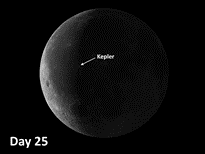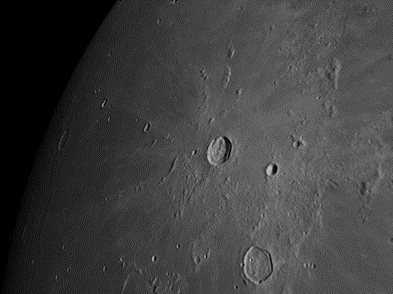The week of April 25 – May 1st takes us from Day 25 to Day 1. This week we will highlight the moon crater Kepler, viewable before sunrise on Tuesday.

 Kepler1: [NW/J6; L=38°W] Kepler is a substantial 20-mile crater with terraced walls and some disappointingly feeble hills in place of a central mountain peak. There is a peculiar straight gash just in from the east rim which forms a long straight valley. Revisit Kepler at full Moon to appreciate how its rays intertwine with those of Copernicus and Aristarchus.
Kepler1: [NW/J6; L=38°W] Kepler is a substantial 20-mile crater with terraced walls and some disappointingly feeble hills in place of a central mountain peak. There is a peculiar straight gash just in from the east rim which forms a long straight valley. Revisit Kepler at full Moon to appreciate how its rays intertwine with those of Copernicus and Aristarchus.
1 Kepler, Johannes: (1571-1630) German astronomer, mathematician, and astrologer who made the enormously important discovery that planets move in elliptical orbits, not perfect circles. His Three Laws of Planetary Motion finally allowed astronomers to calculate the position of planets with much greater precision. (However, Mercury continued to avoid being pinned down. It took Einstein to make the far-reaching discovery that planets do not precisely obey Newton’s laws of gravity because gravity, as it was classically understood, did not exist. Planets are locked into their orbits, not because of gravity, but because space itself is curved!)
An interesting piece of trivia about Kepler is that personal hygiene was not high on his list of priorities. At one point, he noted in his diary that as a result of his wife’s constant pesterings he finally agreed to take a bath. The result? He found the experience “unpleasant.”
======================
It is highly recommended that you get a copy of Sky and Telescope’s Field Map of the Moon, the very finest Moon map available for use at the telescope. It is available for $10.95 at www.skyandtelescope.com and on Amazon. All features mentioned in this blog will be keyed to the grid on the Field Map and will look like this: Plato: [NW/D9]
Credits:
Courtesy of Gray Photography of Corpus Christi, Texas
Lunar photos: NASA / USGS / BMDO / LROC / ASU / DLR / LOLA / Moon Globe. Used by permission
- Rupes Cauchy: A Best Known Fault on the Moon - July 22, 2024
- Moon Crater Schickard – Crater Floor has Stripes - July 15, 2024
- Moon Craters Langrenus and Vandelinus - July 8, 2024
Many of us in the rest of the world, and esp. in the scientific community, would appreciate it if you would please indicate near distances, such as planet radii or crater diameters, ALSO in KILOMETERS. “Miles” simply seems outdated and/or out of place when indicating physical distances beyond the USA, like out in space and on the surfaces of other planets, where KM is more widely used for shorter distances, and AU, LY, PC for farther distances.
We much appreciate receiving your weekly lunar obs. reminders and attached geological insights. Thanks for keeping us posted!
Prof. Lewis Houck
OsloMetropolitan University
Norway